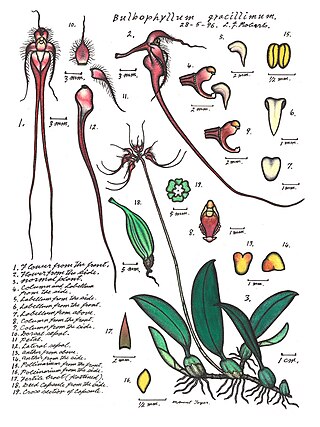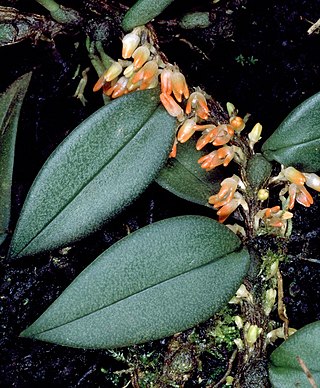
Aa is a genus of plants of the family Orchidaceae.

Heinrich Gustav Reichenbach was a botanist and the foremost German orchidologist of the 19th century. His father Heinrich Gottlieb Ludwig Reichenbach was also a well-known botanist.

Pachystoma, commonly known as kunai orchids or 粉口兰属 , is a genus of two species of flowering plants in the orchid family, Orchidaceae. They are deciduous, terrestrial herbs with one or two linear, pleated or veiny leaves and more or less drooping flowers which do not open widely, on a thin, wiry flowering stem. Species in this genus are found in tropical and subtropical Asia to Australia and islands of the southwest Pacific Ocean.

Bulbophyllum medusae, commonly known as the Medusa orchid, is a species of epiphytic orchid with a creeping rhizome and a single leaf about 100 mm (3.9 in) long emerging from the top of each pseudobulb. The flowers are creamy yellow and arranged in clusters of about fifteen arranged in a circle at the tip of the flowering stem. The flowers have an unpleasant odour. The flowers have thread-like lateral sepals about 120 mm (4.7 in) long, giving each cluster the appearance of Medusa.

Cymbidium hookerianum is a species of orchid found in India, China, and Vietnam. It is distributed widely in Bhutan, especially in the cool temperate forests.

Dendrobium cerinum is a species of orchid that is endemic to the island of Luzon in the Philippines. It was first formally described in 1879 by Heinrich Gustav Reichenbach in The Gardeners' Chronicle. The specific epithet cerinum is derived from the Ancient Greek word kerinos meaning "waxen", "wax-colored" or "yellowish".
Bulbophyllum abbreviatum is a species of orchid in the genus Bulbophyllum discovered in Madagascar and originally described by German botanist Rudolf Schlechter, from material collected by French botanist H. Perrier de la Bâthie in February 1912, which is now kept in the Muséum National d'Histoire Naturelle in Paris.

Bulbophyllum elisae, commonly known as the pineapple orchid, is a species of epiphytic or lithophytic orchid that is endemic to eastern Australia. It has crowded, wrinkled, pale green or yellowish clump-forming pseudobulbs, stiff, pale green to yellowish leaves and between three and twelve pale green to dark green flowers with a dark red to purple labellum. It usually grows in the tops of rainforest trees, on cliff faces or boulders.

Bulbophyllum gracillimum, commonly known as the wispy umbrella orchid, is a species of epiphytic orchid. It has a creeping rhizome, widely spaced, olive green pseudobulbs, each with a single thick, leathery, fleshy leaf and between six and ten purplish red flowers spreading in a semicircular umbel. The flowers have distinctive long, thread-like tails on the lateral sepals. It has a wide distribution and is found in New Guinea, New Caledonia, Indonesia, Malaysia and part of tropical North Queensland.

Bulbophyllum schillerianum, commonly known as the red rope orchid, is a species of epiphytic or lithophytic orchid. It has well-spaced pseudobulbs each with a single grooved leaf and cluster of small, red or orange flowers with a hairy labellum. It grows on trees and rocks sometimes in rainforest but also on trees in cleared paddocks, and is endemic to eastern Australia.

Bulbophyllum shepherdii, commonly known as the wheat-leaf rope orchid, is a species of epiphytic or lithophytic orchid that forms a dense mat of branching rhizomes pressed against the surface on which it grows. The pseudobulbs are well spaced along the rhizome, each with a single egg-shaped leaf and a single small, white or cream-coloured flower with yellow tips. It grows on trees and rocks in rainforest and is endemic to eastern Australia.

Dendrobium johannis, commonly known as the chocolate tea tree orchid, is a species of epiphytic or lithophytic orchid native to Australia and New Guinea. It has spindle-shaped pseudobulbs, between five and ten dark green leaves with purplish markings and flowering stems with up to fifteen chocolate brown flowers with a yellow labellum.

Dipodium pictum, commonly known as brittle climbing-orchid or climbing hyacinth-orchid, is an orchid species that is native to Malesia and the Cape York Peninsula in Australia.
Dipodium squamatum is a mycoheterotrophicorchid species of the tribe Cymbidieae.

Dyakia is a genus of orchids. It contains only one species, Dyakia hendersoniana(Rchb.f.) Onyx, endemic to the Island of Borneo.
Genoplesium calopterum is a small terrestrial orchid endemic to New Caledonia. It was first formally described in 1876 by Heinrich Gustav Reichenbach who gave it the name Prasophyllum calopterum and published the description in the journal Linnaea - Ein Journal für die Botanik in ihrem ganzen Umfange. In 1989 David Jones and Mark Clements changed the name to Genoplesium calopterum. It grows on the island of Grande Terre.

Eulophila zollingeri, commonly known as the carrion orchid or 无叶美冠兰 , is a plant in the orchid family and is native to areas from tropical and subtropical Asia to Queensland. It is a leafless, brownish terrestrial orchid with up to forty reddish brown, sharply scented flowers with a dark red and yellow labellum. It grows in decaying wood in and near rainforests.

Phaius tankervilleaevar.bernaysii, also known as the yellow swamp orchid, is a species of orchid endemic to a small area of Queensland. It is an evergreen, terrestrial herb with large, crowded pseudobulbs, large pleated leaves and flowers that are white on the outside and sulfur yellow inside. Apart from flower colour, the species is identical to P. tankervilleae var. bernaysii.

Bulbophyllum maxillare, commonly known as the red horntail orchid, is a species of epiphytic orchid with tapered grooved, dark green to yellowish pseudobulbs, each with a single large, thin leaf and a single reddish flower with yellow or white edges. The lateral sepals are much larger than the dorsal sepal which in turn is much larger than the petals. It grows on the lower branches of rainforest trees in India, New Guinea and tropical North Queensland.
Phreatia paleata, commonly known as the white lace orchid, is a plant in the orchid family and is an epiphyte with more or less spherical pseudobulbs, each with one or two leathery leaves. A large number of white flowers are arranged along a drooping flowering stem. It is native to areas between Sulawesi and the southwest Pacific.
















